

Pittsburgh
1973-79 Panthers
(Authentic Reproduction)
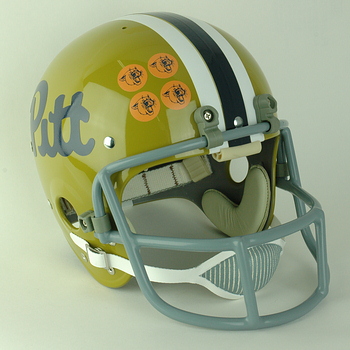
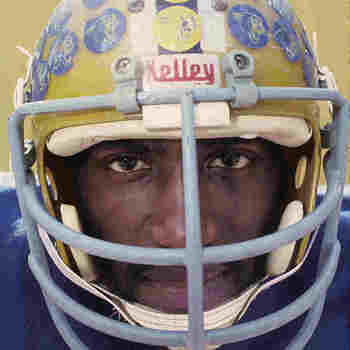
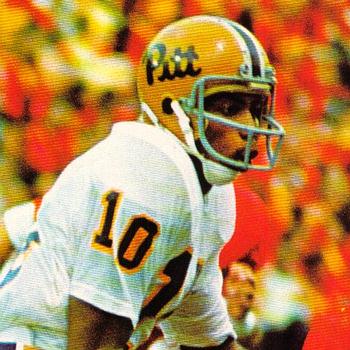
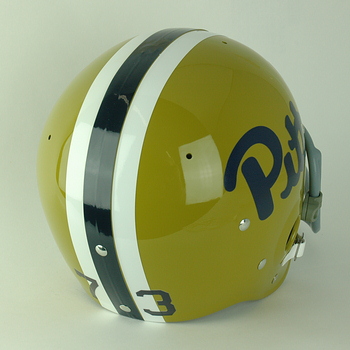
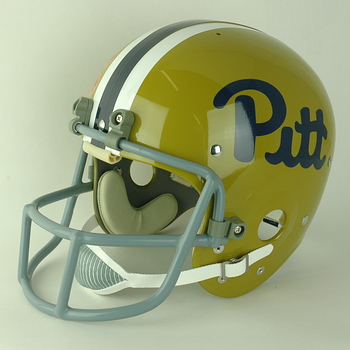
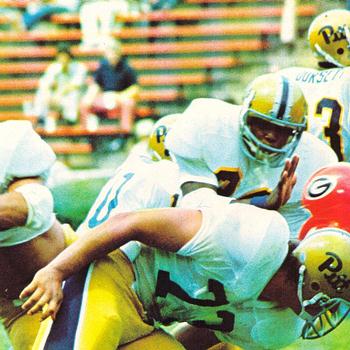
Pitt made the definitive decision to pursue football excellence. The first major action for the Pitt administration was to withdraw from the Big Four Agreement, a self-imposed list of agreed to rules and guidelines between Pitt, Penn State, West Virginia, and Syracuse that governed recruiting standards, admissions, and scholarship limitations. There was a belief on the part of Syracuse that Penn State had ascended to national prominence because they were cheating and Pitt believed they had allowed themselves to be put at a competitive disadvantage with the other three rival schools. The quasi-secret committee assembled to choose the next Pitt head coach narrowed their list to three finalists: North Carolina Athletic Director and former Cincinnati head coach and Kentucky and Oklahoma offensive coordinator Homer Rice; Frank Kush, Arizona State’s head man who had previously accepted the Pitt head coaching position on January 4, 1969, only to change his mind five days later; and Johnny Majors, the former Tennessee great who was Iowa State’s mentor. They hired Majors, a University Of Tennessee All American back and runner-up to Paul Hornung for the '56 Heisman Trophy, as their new head coach. Popular in Tennessee and an eventual member of the College Football Hall Of Fame, he was less known in Pennsylvania but had the proper background for success. The son of one of the most successful high school and small college coaches in Tennessee history, he tuned up his coaching resume and experience as an assistant at his alma mater, Mississippi State, and Arkansas. Majors took his first head coaching position and revived an all-but-dead Iowa State program, taking them to two consecutive bowl games which coincidentally were the only two in the school’s history. He almost didn’t make it to Pitt because the university administration was ready to throw in the towel. As was written, “When Majors arrived on the Pitt campus in December 1972, the school's administration made it clear: They had chosen his gritty optimism over shutting down the program, and it had been a close vote. That first year, the last before the NCAA instituted squad limits, Pitt signed 83 high school seniors, a huge class even by the standards of the era. Among the rookies was Tony Dorsett. Four years later, the Panthers, behind Dorsett's running and quarterback Matt Cavanaugh's passing, streaked to the national title, cementing one of the most remarkable transformations in college football history.”
It was Majors’ ability as an aggressive and effective recruiter that made the difference. Unlike previous Panthers staffs that were manned primarily by former Pitt players and Western Pennsylvania natives, Majors was ably assisted by his former Iowa State staff members who hailed from or who had coached in various parts of the country. This made it possible and eventually easier to recruit talent from Florida and Mississippi and bring in high school players and junior college transfers who made an immediate impact on the Pitt program. Majors’ key recruiter was a former Bear Bryant favorite as an Alabama player and graduate assistant coach, Jackie Sherrill. Few recruited as well as Sherrill and they went out and brought in a number of talented players. Following the lead of Texas and other powerhouse programs, they also brought in a relatively large number of players, now that they had abandoned their previous scholarship limits. Majors’ policy to recruit extremely large classes of players was one of the significant contributing factors that led to NCAA legislation that limited the number of scholarships that could be offered both yearly and in total by any institution. In that frosh class of 1973 were Tony Dorsett, a small but fleet 157 pound running back from Hopewell High School in Aliquippa, PA, quarterback Robert Haygood, tight end Jim Corbett, and defensive linemen Al Romano, Don Parrish, and Gary Burley. Burley represented the “new type of recruit” that under previous coaching regimes, would not have been pursued if only because of geography. He was a two-time Junior College All American at Wharton JC in Texas and the target of many southern and southwestern schools. All would contribute to the immediate improvement of the squad and the rise to national prominence. Majors then installed a winter conditioning program that might have been the norm at Alabama or Arkansas but shocked the Panthers who had labored under Carl DePasqua and who were used to "typical Eastern football preparation." It was brutal, it was demanding, and many of the previous regime’s players packed it in. Fullback Dave Janasek and quarterback Bill Daniels, holdovers from the year before, didn't and performed well with the newcomers, as did captain Dave Wannsteadt who manned an offensive tackle position and led the blocking charge in Majors' option offense. Wannsteadt of course would go on to a lengthy coaching career as a college and professional assistant and head coach, including a 2005-2010 stint as the Panthers head man. One of the "small details" that excited the players was a uniform change. The heavier, old-fashioned Durene jerseys were exchanged for lighter, mesh and the backs were given tear-away jerseys. The helmets were a new, rarely seen mustard color with a one-inch Navy blue center stripe and three-quarter-inch white flanking stripes. The shell was highlighted by a Navy blue script “PITT” logo on each side, and one-and-one-half-inch Navy blue player identification numerals on the rear of the shell. For those players who would earn them, circular award stickers, both gold with a blue panther head, and blue with a gold panther head, would be affixed to the helmet and as Pitt improved, they certainly needed to order many of these! Dorsett's 1686 yards set a NCAA rushing record for freshmen and earned him All American honors, the first freshman to carry that distinction since 1945. The new 4-4 Defense prevented all but Notre Dame and Penn State from putting up a lot of points. The 6-4-1 record was a huge improvement from previous seasons and earned a berth against Arizona State in the Fiesta Bowl, the Panthers first bowl appearance in seventeen years. Even a 28-7 loss there did not dampen enthusiasm. Pitt was on its way. The recruiting and rebuilding continued and did so in a hurry. Joining Dorsett, who punctuated his rookie performance with another 1004 rushing yards was freshman quarterback Matt Cavanaugh who shared time with Robert Haygood and both utilized soph tight end Jim Corbett's abilities well. As Dorsett stepped into the starring role, new running back Elliott Walker was brought in from Miami and immediately won playing time. In the only game Dorsett missed in his collegiate career, Walker ran for four touchdowns against Temple. On defense, rookie defensive back Bob Jury and tackle Randy Holloway were immediate starters, augmenting the play of Parrish, Romano, junior All American nose guard Gary Burley and the others that were brought in the year before. The 7-4 record was dampened by losing the final two contests to Notre Dame and Penn State but all of the elements were coming together for something very special.
For the 1975 season, Majors, Sherrill, and the rest of their aggressive staff again recruited some of the best players not only in the Northeast, but in the South. With quarterback Haygood and running backs Dorsett and Walker, the staff installed the Veer Offense to get them onto the field at the same time. Dorsett of course was the bell cow, a genuine All American, hurling his 184-pounds around like a ping-pong ball and finishing the season with 1686 yards and a fourth place finish in the Heisman Trophy balloting. His three-year total of 4134 put him in position to go into his senior season in '76 with a chance to break Ohio State’s Archie Griffin's all-time career rushing record. Dorsett's top game was a 34-20 payback win over Notre Dame where he finished with an astounding 303 yards! Haygood was eventually sharing time with sophomore Matt Cavanaugh whose favorite receivers were All East tight end Corbett who pulled in twenty-four receptions and exciting freshman wide receiver Gordon “Too Much” Jones, a terrific kick returner who caught twenty-two passes. Offensive tackle Glenn Hyde remained an anchor and then went on to a decade of NFL football, primarily with the Broncos. With Carson Long one of the country's best place kickers (despite a poor outing against Penn State only hours after his wife had given birth to their son), the offense was potent but the real power was in the defense. Giving up only 13.4 points per game, the cast was becoming familiar and playing well together. Defensive linemen Burley who played eight years with the Bengals and one with the Falcons, Randy Holloway, Don Parrish, and Al Romano were stout up front and linebacker Arnie Weatherington added 143 tackles to the mix. The 7-4 mark won a trip to the Sun Bowl and a victory over Kansas with Haygood, Walker, and Dorsett all rushing for over 100 yards each. The excellent 8-4 finish and final season number twenty ranking created anticipation for 1976 and the climax of Tony Dorsett's career.
THE NATIONAL CHAMPIONSHIP YEAR OF 1976:
Pitt’s 1975 finish at 7-4 led to the 1976 pre-season number nine ranking. While no one was predicting an undefeated, National Championship year, Head Coach Majors who was destined to win every organization’s Coach Of The Year Award, sensed that something very special was happening at Pitt. Assistant Jackie Sherrill departed to become the head coach of Washington State but his effective recruiting had stocked the Panthers roster. Of course, running back "TD Tony" Dorsett was the primary reason that great things were predicted, a three time All American who at times seemed to be unstoppable. Up until 1969, statistics noted that Beaver County, PA produced college football players at a 3.99 per capita rate, second only to Steubenville, Ohio at 4.66. Aliquippa's Dorsett was becoming a name as big as Beaver County's other favorite son, Joe Namath and he made his intentions known on the first play from scrimmage in the season's opening game as he romped for a sixty-one yard touchdown against Notre Dame. He didn’t finish running until he had set twelve NCAA records including marks of 6526 career rushing yards, 1074 rushing attempts, 356 points scored, all-purpose yards, four seasons gaining 1000 yards or more and three seasons with 1500 or more. He also was able to do it in the biggest games, gaining 202 against Georgia in the Sugar Bowl game that would determine the National Championship and 224 against Penn State, playing fullback and running almost exclusively up the middle the entire second half. The supporting cast however, was now the envy of most other schools, a product of the aggressive and effective recruiting done by Majors and Sherrill. Running back Elliot Walker and receiver Gordon Jones kept some of the attention off of Dorsett and three different quarterbacks came through when called upon. Robert Haygood went down with a knee injury against Georgia Tech in the season’s second game and Matt Cavanaugh stepped in. When he broke his ankle the next week against Louisville, former ninth string walk-on Tom Yewcic, the son of the former Michigan State and Boston Patriot quarterback of the same name and a future member of the Pennsylvania State House Of Representatives, kept the wins going for another four weeks until Cavanaugh could return. Behind the effective offensive line of captain and center John Pelusi who eventually became a member of Pitt’s Board Of Trustees, tackle John Hanuauser and guards Tom Brzoza and Matt Carroll, it seemed like everyone had their own caravan. Nose guard Al Romano was also an All American and considered by many as the best in the country. The defensive wall of Romano, Don Parrish, Randy Holloway (who had 16 sacks), and linebacker Arnie Weatherington was formidable. Safety Bob Jury and Monster Jeff Delaney combined for sixteen interceptions. Only the 24-16 win over West Virginia was remotely close. Tight end Jim Corbett moved on to the Bengals for four years and Parrish played both nose guard and defensive end for the Chiefs from 1978 through 1982. Carson Long finished his career as one of the best kickers in the country and had a brief fling with the Bills in '77. After defeating number four ranked Georgia in the Sugar Bowl by a convincing 27-3 score, Majors quietly informed his team that he was returning to Tennessee to take on the head job there and that Jackie Sherrill would return to the Panthers and move in to take his place.
SPOTLIGHT ON TONY DORSETT:
Coming out of Hopewell High School in Aliquippa, PA, the 157-pound running back Anthony Dorsett was the apple of every college coaches' eye. The smart money was on Penn State, the reigning Eastern power but as Dorsett said, "Pitt (referring specifically to Head Coach Johnny Majors and assistant Jackie Sherrill) made me feel like I was very important to them." He immediately won a starting tailback position and made his first of what would be four All American teams, the first freshman to do so in three decades. His 265 rushing yards against Northwestern helped. By 1976, he was a consensus All American pick and the winner of both the Heisman and Maxwell Trophies and deservedly so. He gained over 1000 yards in each of his four seasons and did so when everyone in the stadium knew he was going to carry the football. Despite being targeted by every opponent, he still gained 6526 rushing yards in his career for an NCAA record and was most proud of the fact that he had broken the record for the number of carries, proving his durability. In all, he left Pitt with twelve NCAA marks and the distinction as one of the greatest college players of all time. Maturing to a well muscled 192 pounds by his senior year, he could run with speed or power and always ran elusively. In an eleven-year NFL career, he performed at a Hall Of Fame level with the Cowboys, playing his last season with the Broncos. He was NFL Offensive Rookie Of The Year with 1007 yards and 12 touchdowns and continued the pace, running for over 1000 yards in eight of his first nine years in the league. Dorsett's 12,739 rushing yards and 16,326 total yards from scrimmage with 546 points remain huge numbers, even in this day of "basketball-on-grass" offense. He has been elected to both the Pro and College Football Halls Of Fame and remains one of the best of the all-time greatest Dallas Cowboys players.
It was impossible to expect improvement in the National Championship performance of 1976 but with Jackie Sherrill in charge of the Panthers, it happened as the Pitt program gained a consistency in excellence that made them a top team every season. Recruiting was even more impressive. Sherrill returned to Pitt after a one-year absence as head coach of the Washington State Cougars, and the yearly NFL draft list under his watch included a number of Panthers players for a five year period. Sherrill’s coaching and recruiting aggressiveness reflected his tough upbringing which led him from his birthplace in Oklahoma to a daily grind of hard work on his brother’s chicken farm in Biloxi, Mississippi as a teenager. Recruited by Alabama, he played fullback and linebacker on two National Championship teams before becoming a graduate assistant coach under Paul Bryant at his alma mater. Learning as an assistant for legendary Frank Broyles at Arkansas added to his resume and he went to work for Majors at Iowa State as his Assistant Head Coach and Defensive Coordinator. When Majors came to Pitt, Sherrill came with him and his return was welcomed by the players and fans after his year at Washington State. There were many graduation losses to overcome for the 1977 season besides the incredible Dorsett but quarterback was in good hands as Matt Cavanaugh had a superlative All American senior season before heading off to eventually have a long pro career with four different teams, and a successful coaching resume that included four years as the Pitt offensive coordinator. He was ably backed up by '76 surprise stand-in Tom Yewcic and both enjoyed the rushing of Elliott Walker who spent ’78 with the Forty-Niners, and the receiving of Gordon Jones and Willie Taylor. The offensive line still had All American center Tom Brzoza and tackle Matt Carroll but it was the defensive line that was primarily responsible for the gaudy 9-2-1 record and Gator Bowl defeat of Clemson in rather easy fashion, 34-3. Defensive end Randy Holloway and Safety Bob Jury both joined Brzoza on the All American lists and Holloway had an effective career as a first-round draft choice of the Vikings, playing until 1984 when he finished with the Cardinals. Jury completed his Pitt career with a school record twenty-one interceptions and played briefly for the Forty-Niners. With Al Chesley joining the group of starting linebackers, Sherrill's frosh had to push for playing time although one, Hugh Green, had an amazing All American debut at an outside linebacker spot. Although the '78 team dipped to 8-3 and then dropped a 17-3 decision to North Carolina State in the Tangerine Bowl, this season was a prelude to true greatness. Sherrill assembled a squad of players that would mature the following season and complete a 33-3 run that would make the Panther locker room look more like NFL-Central. Quarterback Rick Trocano was dependable and had a host of weapons: backs Rooster Jones and Fred Jacobs, who garnered 634 yards on the ground; receivers Artrell Hawkins, Benjie Pryor, and Gordon Jones, an All American who played for the Bucs and Raiders before becoming a physical therapist; and offensive lineman Mark May. The strength of the team was in the odd-man line defense with front men Bill Neil, Jerry Boyarsky, and the super-quick Greg Meisner. Behind them was linebacker Sal Sunseri, defensive backs Jeff Delaney, Carlton Williamson, and All American Jo-Jo Heath. The gems of the defense however, were the two defensive ends/outside linebackers All American Hugh Green and his bookend from Florida, Ricky Jackson. They were devastating and at times, unstoppable and still maturing.
Switching offenses for the ’79 season to a Multiple Pro Set to better utilize the talents of First Team High School All American and new frosh quarterback Dan Marino, the team blossomed on both sides of the ball. Sherrill had assembled an almost ridiculous amount of talent and they found a way to play together. They dropped the second game of the season to North Carolina 17-7, looked each other in the eye, and reeled off ten straight wins. Marino was ably backed by Rick Trocano but Marino played enough to throw for 1680 yards to the likes of Pryor. The offensive line was impressive, led by All American mammoth Mark May who was considered to be the best in the nation by many. Center Russ Grimm teamed with May to blast open holes for Harford (MD) CC transfer fullback Randy McMillan. It was again the defense however, with three-time All American Hugh Green in tandem with Ricky Jackson that made this a feared unit. With big-boys Jerry Boyarsky at nose guard and Greg Meisner and Bill Neil manning the tackles, the line was incredible. Placing linebacker Sunseri and secondary players Jo-Jo Heath and Carlton Williamson behind them, one could look at the record and nod, "Yeah, it figures." They closed the season with a 16-10 victory over Arizona in the Fiesta Bowl and looked forward to 1980.